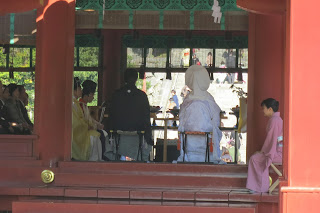November 15th is Shichigosan Day (literally 7-5-3), a day set aside for girls ages 3 and 7, and boys ages 3 and 5. This day is a traditional rite of passage for these age groups and celebrates the general growth and well-being of these children. This festival is believed to have originated in the Heian Period (794-1185) and was observed by nobles who celebrated the passage of their children into middle childhood. The ages are all odd numbers - Odd numbers are considered lucky in East Asian numerology. Historically, this day marked the time when the 3 year old boy and girl could start growing their hair out - as up until this point, they were required to have shaven heads. Girls of age 7 also replaced the simple cord tying their kimono at the waist with the traditional obi.
 |
| The obi - versus just a simple cord like string around waist |
These traditions have since changed - however it is still common practice to have girls age 3 and 7 and boys age 3 and 5 dress in kimono (often for the first time at age 3) and visit a shrine. The visit to the shrine has been the constant tradition for this festival - and is believed to drive out evil spirits as well as to wish for a long, healthy life.
Below are some of the pictures from the festival:
 |
| 3 year old girls wear these padded vests or hifu over the kimono |
Children at the festival are given Chitose Ame - literally meaning "Thousand Year Candy". It is a long, thin red and white candy, and presented in a bag decorated with cranes and turtles - all which symbolize healthy growth and longevity.
You can see some of the kids in the pictures holding similar bags.
Another event where the kimono plays a role is a traditional Shinto wedding. More and more Japanese are choosing a modern Western style wedding but many continue the tradition of the Shinto version. The clothing is very luxe and elaborate - men wear a type of kimono called the kimono-hakama-haori.
Women wear an all white kimono - called a shiromuku. Made of expensive silk, some of the modern ones have a subtle trim color at the hem or a iridescence to the fabric. Symbols of cranes, peacocks, ribbons, fans or pine are embroidered into the fabric. Another tradition is the wataboshi (hood), or the tsunokakushi (elaborate hat).
The white hood is to cover the bride's "horns of jealousy", as well as to symbolize that she is ready to enter her new home with husband with openness and obedience.
Here are some pictures of the ceremony that we saw:
During the ceremony, many rituals are preformed, including sipping 3 times from cups of 3 different sizes, drinking only at the third raise, presentation of a sakaki branch to the alter, exchanging of rings and lastly everyone in attendance drinking sake.
Some new food discoveries - while eating lunch I noticed that my rice was extra tasty and salty. I had eaten most of the bowl and then realized that what I was eating looked like a tiny fish with eyes. Sure enough, it was. They are chirimen jako - or young sardines. They are used as topping in rice, in green tea, or as an appetizer with drinks or with porridge.
The other new thing that we came across is when Kenny ordered what he thought was a simple beer. However it was served with a small amount of ShoChu (whiskey like alcohol) in a large glass. The "beer" is actually a beer type soda - it contains 0.8% alcohol, and is meant to be mixed with the ShoChu. When introduced, it was a considered a substitute for beer - since beer was quite expensive and ShoChu very cheap. Apparently, it has recently made a revival in Japanese pubs.
That is all for now - Oyasuminasai (Good night!)




















No comments:
Post a Comment